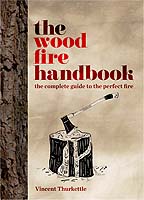The compete guide to the perfect fire.
Wood Fires

Woodsman Vincent Thurkettle
How to Select the Best Firewood
Many people thoroughly enjoy learning about the different types of firewood. They
find that this knowledge enriches their wood fires lifestyle, making it more fun
and enhancing their understanding of the woodlands and forests around them. But,
without wishing to be boring, it is worth noting that (dry weight for dry weight)
the heat value within all logs is roughly the same. So, if you make sure that your
logs are well seasoned (dried to 20-
Excellent firewood includes the species with a high density that burn well, such as: Oak, Beech, Hornbeam, Elm, Field Maple, Robinia, Hawthorn, Hickory and rarer woods such as Yew, Box, Laburnum and Rowan.
Good firewood includes medium density woods, such as: Alder, Ash, Birch, Eucalyptus, Fruitwoods, Hazel, Holly, Plane, Sweet Chestnut, Sycamore and Walnut. It’s worth noting that while many people rave about Ash as firewood, this is because it splits easily and will burn unseasoned. In terms of the heat value per log, Ash is well down the list.
Poor firewood is still fine to burn in a wood stove, it just takes up much more room in the wood shed and is not great on an open hearth as it burns too quickly and may spit sparks. This class would include: Willow, Aspen and other Poplars, Horse Chestnut, Lime and most conifers.
When seasoning your logs, remember that the less dense firewood types will dry out
much more quickly than the high density species, and split logs will dry more quickly
than logs with the bark still intact. There are no absolute rules of thumb for how
long you should season your firewood -

